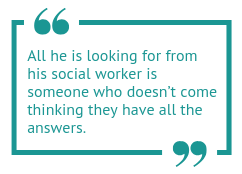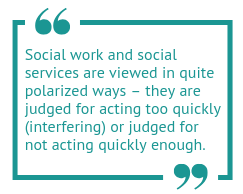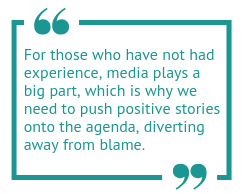How Seamab sees it
Topic: Education, REACH, Residential care, Voices of young people
Author: Joanna McCreadie
Seamab is a children's charity based in Perth and Kinross providing care and education for vulnerable children from across Scotland. The charity is managed by a team of professionals from different disciplines and REACH asked them to reflect on their experiences of working in social care and misconceptions about the care and support of children and young people.

Firstly Joanna McCreadie, Chief Executive, introduces the team:
Jody Cannon, our Learning Co-ordinator is qualified in Community Education and in the delivery of outdoor education. Jody specialises in delivering creative and engaging learning experiences, focused on health and wellbeing.
Kath Cooper is our Head of Education and has worked in primary schools as a teacher, support for learning teacher, staff trainer, and deputy head. Kath is developing the delivery of the curriculum and learning and teaching at Seamab.
Tamsin Ferrier, our new Director of Development, was appointed earlier this year to lead our fundraising team. She is currently working on fundraising that helps to improve outcomes for children.
Gary Gallacher is our Head of Care and has previously worked in a number of different settings, including local authorities and charities. Gary is qualified in Community Education, and has a strong commitment to the empowerment of children.
And then there’s me, Joanna McCreadie, a qualified social worker. I’ve worked in a number of different settings including local authorities, the independent sector, and national inspectorates. I am particularly interested in developing practice to help children recover and heal from trauma.
How do you think working in a multi-disciplinary team affects the work you do?
GARY: Working this way provides a greater amount of insight and knowledge on the needs of the whole child, rather than just the focus on one area. It allows the opportunity to have a greater impact as you are aware of how to support the child across the home, community, and education settings. It also acts as a challenge to learn from each other, and to set outcomes for children through collaborative working.
KATH: This enables us to best meet the needs of the children and young people. Professionals, care team and education staff share information in order to ensure individual needs are met.
JOANNA: I find that working with people from different professional backgrounds brings a different kind of challenge to my work: often, I will be looking at an issue from a social work perspective and other members of the team will question or challenge this. I also find that as we discuss issues as a team, more dimensions and knowledge are added, and inturn this means that we develop a multi-faceted approach to our work.
JODY: The multi-disciplinary collaboration ensures that the children at here receive the most holistic care and education. With practitioners of different professionalbackgrounds Seamab is ableprovide a model of education and care thatutilises different cultures, fosters innovation and creativity. The work I do benefits from the collaboration of a number of practitioners and agencies.
TAMSIN: Forme it is great, as it allows us to tailor funding applications to areas of work that funders would be interested in. It allows us to demonstrate that we are providing whole care and experiences to young people who really need it.
Do you recall any particular role models, examples or stories that have really had an influence on how you approach your work? Can you describe how these have influenced you?

JOANNA: I started my career working in secure care and was deeply affected by the stories of the children I supported. It was my first paid job working with children and I really didn’t know a lot about child development or trauma. So a lot of the time I was learning from the direct experience of working with these children and from what they communicated. Having fun, newexperiences, and positive relationships were what I found worked best. There’s now research that backs this up but I still believe that we have to learn directly from each child what it is that works for them.
JODY: Actually, I think spending ten years in Stirling County’s junior rugby section has helped me the most. There were hugely positive role models there for me - you had to mix with a very diverse group of children and you had to train hard and work as a team for the benefit of everyone. This has helped me develop and comprehend the important role adults play in the progression of each child.
KATH: A working lifetime of trying to listen to and defend the rights of those who require more support for a huge variety of reasons. That has helped me to see the worth in everyone.
TAMSIN: The children at Seamab are a massive influence, hearing their stories and seeing them develop ignites a passion to be able to deliver the best possible service we can to allow them to be their best. We can only do that through raising additional funds so we must ignite the same passion in our funders.
What in your experience is the biggest misconception about social care?
JOANNA: For me, the biggest misconception is that we can just fix kids. Firstly, children in care don’t need fixing. They are often survivors of trauma but they are also like all other kids in terms of their wants and needs. Secondly, there is no simple answer or one size fits all – recovery is about a journey that is deeply individual for every child. Thirdly, that children in care are somehow different to your own (or mine). They’re just not.
GARY: That residential care is a last resort for children who have suffered a breakdown in all areas of their lives and suffered a number of broken placements. I feel that residential care can provide a positive option to support children and stabilize their lives, allowing some to move on to other options for care, including foster and adoptive care. I also think that for some children residential care makes more sense to them and will be the best option to see them into adulthood.
KATH: That children or young people using the service are ‘bad’, or ‘deserve’ the treatment they have had.
TAMSIN: I think overall the biggest misconception is that social care is a negative experience; that is about ticking boxes and that care is not always at the forefront. Also, it’s often assumed that statutory funding is enough to fund for everything we do, or that it should all be met by the local authority.
JODY: In my experience, the biggest misconception is that you can’t access and provide the same experiences as you can for children in mainstream schools. This is possible if you work at it.
And what do you think is the most common misunderstanding or misconception of social work and social services specifically? What do you think influences these perceptions?

TAMSIN: Social work and social services are viewed in quite polarized ways – they are judged for acting too quickly (interfering) or judged for not acting quickly enough. There is little appreciation for all of the times that dedicated and skilled staff make a positive difference in people’s lives.
JOANNA: There seems to be a common perception that social servicesis for a particular section of society, but the truth is almost all of us will need support at some time or stage of our life, for ourselves or a member of our family. This misunderstanding contributes to the stigma for people of getting involved with social services, especially for children and families, and acts as a really unhelpful barrier.
What’s the most challenging aspect of engagement for you when seeking to work with people who might not be familiar with the needs of children in need of care and their families?
JODY: It’s difficult when adultsin particular makejudgements about children without understanding the child’s story. Without this understanding, it’s impossible to understand what is best for the child and the motivations behind theirbehaviour.
GARY: Understanding the complexity of need. Most people don’t have experience or come into contact with children as vulnerable as thechilden within our setting. This often means they think from their own experience of a child or young person who they have come into contact with, who has had some degree of challengingbehaviour. This creates some difficulty as they judge based on this experience, without the understanding of the abuse and trauma our kids have experienced and they often simply see thebehaviour as a result of this.
KATH: Perceptions can be challenging. Part of our approach with children is acceptance. Allbehaviour is communication, and we strive to better understand our children and young people on an on-going basis. We also believe that people and adults are usually doing the best that they can, and sometimes require support.
JOANNA: People can find it barely credible that children should be treated so appallingly and they struggle to understand how children can recover. I think it’s really important as well that children are not defined as victims, or as trapped in their past experiences. So, it then becomes our role to explain complex issues in the language of the layperson. This is especially important in the context of gaining a much wider understanding across society of the needs of children in care.
TAMSIN: We need to be emotive to engage funders and supporters but we are incredibly mindful that we need to be sensitive and protective of the children in our care. It can be difficult to know how to tell that story in an emotive,hard hitting, yet sensitive and respectful way.
How do think stigma might affect the life chances of the young people you work with?
TAMSIN: I think people make assumptions based on the statistics surrounding outcomes for care experienced young people. These assumptions will affect the opportunities that young people are offered, and they affect the opportunities young people think they deserve. I hope one of the things we help children do at Seamab is to believe in themselves.
GARY: Our children are surrounded by a lot of professional jargon, relationships and meetings - very little of which they understand - and yet this has such a bearing on their lives. This can cause a feeling of helplessness and lack of control over their own lives. I think this creates a stigma in their own minds, initially around their worth in society. Once leaving care they are then exposed to a lot of negative media about care leavers, which could make them feel even moremarginalised.
JOANNA: Children and young people affected by trauma often have a very deep sense of shame about their experiences, and a feeling that they were responsible for what happened. Stigma reinforces and adds to this, and it becomes very difficult for children to overcome their beliefs about themselves. All of our children have capabilities and talents, but it can be much more difficult for looked after children torealise these because of their prior experience, stigma and a lack of focussed support on what they need as individuals.
What do you think influences the general public’s attitudes and perceptions of children and families in need of support?
JODY: Personally I’ve had many, many more positive experiences than negative. I think that the publicin generalwant to help children and families in need of support. Many companies and employers do too, especially when they understand the experience of children.

KATH: Children and families in need of support are portrayed as ‘different’, and they are not different.
GARY: There is a lot of negative media and press around children in care and their parents. It is sometimes forgotten that, given the experiences that their parents have been exposed to and the conditions they live in such as poverty, families are often doing the best they can.
JOANNA: I think a range of different factors are at play – news stories, programmes and films, personal experience, the communities they live in. I’ve always been conscious that many of the representations of children and families who need support are negative and can be very blaming. When we developed the branding for Seamab, we wanted to articulate the real experiences of children and to be positive about who they are and what they can achieve. This was part of our commitment to challenging some of the narrative around children in care.
What one thing do you think would help people to see what young people are capable of rather than the challenges they might face?
KATH: The way we describe people facing challenges in the media and in general should be better. We are people first, not our experiences.
TAMSIN: We need to reframe the narrative. Children are being given their best chance to be adults who flourish. Let’s talk about the successes that are being achieved in spite of the trauma experienced, and about what we as a sector are doing to facilitate that success.
JOANNA: I think the care experienced people who are speaking out, the work of the Independent Care Review, the support from the First Minister, and the campaigning work by Who Cares?Scotland, is starting to change perceptions. I was on the recent Love Rally in Glasgow and I was very moved by how supportive and enthusiastic people were - cheering on the marchers, waving and joining in with chanting. I think the more we share stories and raise awareness the more people will understand about children in care and their real capabilities.



